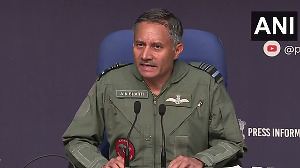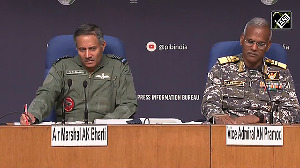Mulayam Singh's bid to get a third front on his side is to get into a position where he can barter for the prime minister's job with the support of either the BJP or the Congress, says Seema Mustafa.
Samajwadi Party leader Mulayam Singh Yadav has again joined hands with the Left parties and the Telugu Desam Party to protest against the United Progressive Alliance government on the issue of corruption, or to be more precise, the coal scam. In the process he has revived talk of a possible third front, within his own party and of course the media. The Left and the TDP are more cautious about this solidarity, having been bitten more than once in the past by the wily leader from Uttar Pradesh.
It is almost certain, unless there are dramatic twists and turns in the run up to the general elections, that the Bharatiya Janata Party and the Congress together will get a minority in Parliament. Lately, the BJP has tried to get all its factions together in a unified protest against the UPA government, and more specifically Prime Minister Manmohan Singh.
The Bangalore rumours making all north-easterners flee the state in fear of their lives after the violence in Assam might or then might not help the BJP in the long run. For as the dust and the fear subsides, and some sense returns, the people will realise that they have been conned by unscrupulous forces into taking positions that they would not otherwise have. Already sections of the media are reporting the involvement of Bajrang Dal men in spreading fear and terror in Karnataka.
There is no doubt anger and resentment at the spiralling prices, corruption and mis-governance. Anger that has reached new levels in recent years and is directed against the UPA government of course, but also against the BJP that has been unable to present a cohesive image and has been supporting similar economic policies at different levels. There is thus, as always space for a third alternative to lead from the front but unfortunately the regional leaders and parties have been singularly incapable of marshalling this to their advantage. In that oversized egos and ambitions come in the way of serious discussion and cooperation between the regional parties, with the party presidents resembling warlords fighting imaginary battles.
Mulayam Singh's bid to get a third front on his side is to get into a position where he can barter for the prime minister's job with the support of either the BJP or the Congress. The effort is not to thrash out a working third alternative with all capable leaders on board, but to bring in some sort of a nucleus that can then bargain for the top job based on the number of seats in hand. This is one of the primary reasons why he insisted on his son becoming the chief minister of Uttar Pradesh, so that he could be free for the Centre.
The strategy, in terms of opportunistic politics, might be sound but the manner in which Mulayam Singh is approaching the issue is strange. In trying to keep his options open he is making no friends, with the Congress wary of his antics, the Left visibly suspicious, and the regional parties reluctant to commit themselves to any long term relations.
No one has been able to forget his flip flop on the crucial India US civilian nuclear energy agreement that helped the Congress get it through Parliament. All principles were thrown to the wind as Mulayam Singh made it clear that he and his party were up for sale on this issue. And as other political leaders point out this could happen again, and yet again, making Mulayam Singh an uncertain commodity at even the best of times.
Of course, the regional party with the highest number of Lok Sabha seats will be in an advantageous position in 2014, more so if the BJP and the Congress are unable to convince the electorate of a serious change of heart. Janata Dal-United leader Nitish Kumar is a major contender and given the fact that he has an alliance with the BJP, he could become the National Democratic Alliance's choice for prime minister if the BJP does as badly as is expected in the polls.
However, Nitish Kumar will have to contend with Mulayam Singh whose party is expected to repeat its record in the general elections as well. If that happens, the Samajwadi Party leader could emerge as the regional leader with the largest number of seats in Parliament, and will look for support and help first from the Left and the willing regional parties to build a block that can convince the President of India that he can indeed stake a claim to form the government. And then approach the Congress, (it is unlikely that he will go to the BJP at least at this point in time) to support the third alternative from the outside.
Of course elections in India always have a way of remaining unpredictable, but this is the scenario that Mulayam Singh has in mind these days. He has started making common cause with the old third front political parties, to firm up alliances and at least some basic agenda of functioning together. But Mulayam Singh never works in a straight line, he prefers following a circular path with wheels within wheels inside. It is thus unlikely that he will be greeted with open arms, with the Left parties having taken a decision that they will cooperate with all secular parties on issues even as the broad thrust remains against both the Congress and the BJP.
All said and done, Mulayam Singh has sounded the election bugle and the build up will peak in 2014 when the electorate braves all conditions to queue up and vote for good governance. There will be innumerable permutations and combinations along the way, and it will be a while before the picture of coalitions and alliances will be clear for the voter to pin hopes on.








